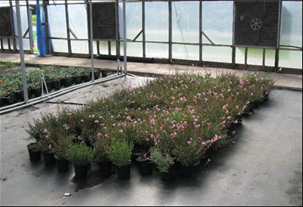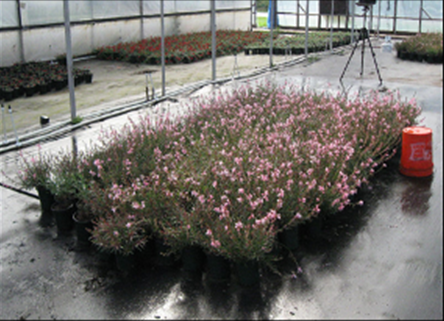You are here
Strategies
 Gaura lindheimeri plants that were overhead irrigated either using standard monitoring practices (above) or irrigated by using soil moisture sensor data (below).
Gaura lindheimeri plants that were overhead irrigated either using standard monitoring practices (above) or irrigated by using soil moisture sensor data (below). 
Comparing water use with sensor-controlled versus standard irrigation: In this deployment example, we compared the water use of Gaura lindheimeri plants that were irrigated either using standard practices (Will Ross watered these plants as he usually does) or using soil moisture sensors (10HS, Decagon Devices) connected to a datalogger (CR200, Campbell Sci.).
Three sensors were installed in the sensor-controlled plot and the datalogger averaged to soil moisture readings of the two sensors reading highest. The sensor with the lowest reading was ignored to prevent erroneous sensor readings turning the irrigation system on. Plants were irrigated when the average of the two sensor readings dropped below 35% volumetric water content.
Surprisingly, sensor-controlled irrigation resulted in 18% higher water use than ‘standard’ irrigation.
Substrate water content was more stable, and higher, in the plot were irrigation was controlled using soil moisture sensors. Also surprising was the clear visual difference between the crops, with plants in the sensor-controlled plot which had a much greater percentage of flowering (lower right).
Perhaps the most important outcome here was that Will Ross, gained confidence in soil moisture sensor-controlled irrigation, and is willing to try this out on a larger scale.
